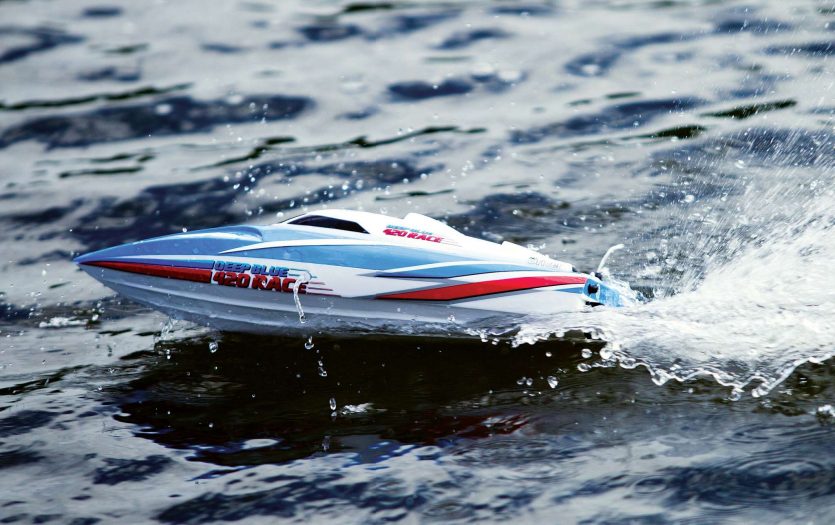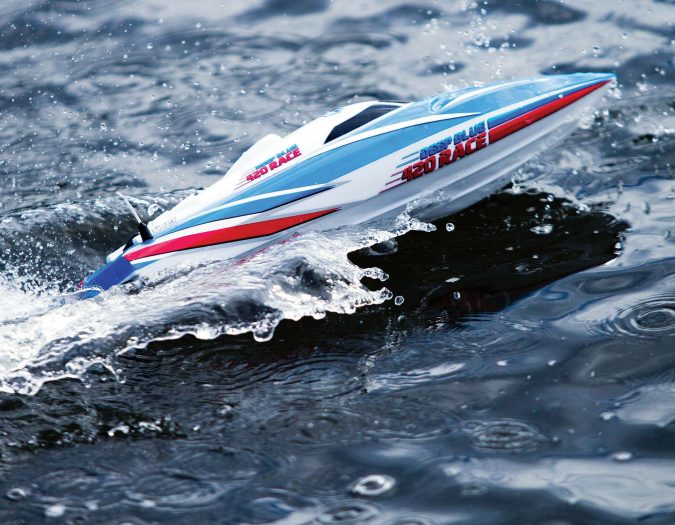Don’t get stranded!
Words Mark Ronge Photos Edwin Rodriguez
There is no doubt that the world of radio control boats can be tough to break into compared to our land- based counterparts. If our four-wheeled vehicle flips over or has an electronic failure, we just walk over and get back up and running right away. With boats you can’t really do that… or can you? The LRP Deep Blue 420 Race is an RTR boat that has the capability of righting itself when flipped over and comes equipped with some of the most reliable electronics on the market. Couple the reliability and ease of use with a blistering fast performance and you have a recipe for one hot RTR speedboat you can enjoy regardless of your skill level.
AT A GLANCE
WHO MAKES IT: LRP
WHO IT’S FOR: Everyone
PART NUMBER: 310104
HOW MUCH: $189.99
BUILD TYPE: RTR
PROS
• Excellent water cooled LRP brushless ESC and motor
• 2.4GHz FHSS transmitter and receiver included
• Boat can flip itself over if upside down
• CNC machined aluminum rudder
CONS
• Receiver is not fully waterproof (a rubber balloon is included to help seal it off)
REVIEWER’S OPINION
The LRP Deep Blue 420 Race is an excellent choice for an RTR boat. Just supply your own 3-cell LiPo and you will be rewarded with one of the more forgiving boats to drive on the market, with impressive performance to back it up. The number of times I was saved from taking a swim by the self-righting feature of the Deep Blue is more than worth the price of admission.
TOOLS AND ACCESSORIES INCLUDED
• 2mm Allen wrench
• Dean’s style battery adapter and shrink tubing
• Balloon and rubber band for receiver
• Spare propeller
• Plastic boat rack
ITEMS NEEDED
• 3S 11.1V LiPo battery
• 4X “AA” batteries for transmitter
ITEMS USED
• LRP Expert Line 1800mAh 3S1P 11.1V 30C LiPo
OUT OF THE BOX
The LRP Deep Blue features an aggressive deep-V hull design constructed of a tough ABS resin. All of the internal components are well sealed with a fairly substantial gasket sealing the canopy and held in place with an easy-to- use lever. While the deep-V hull is a classic speedboat shape, the LRP Deep Blue is capable of flipping itself over just by using the torque of the brushless system. The hull is very neatly packed, with plenty of room for a 3-cell (not included) LiPo. The LRP 1800mAh pack fits perfectly with room to spare, I could also fit 2200mAh packs in without issue since the packs are secured via hook and loop material.
There’s no doubt about it, LRP makes some of the highest quality RC electronics out there and the Deep Blue is equipped with an awesome setup. Fuel tubing helps bring outside water into the hull which helps to cool both the motor and speed control. The speed control is a 30 amp brushless ESC with water cooling functioning through an alloy heat sink. A 2900Kv outrunner brushless motor turns the prop and also features water cooling. The receiver and transmitter combo is definitely one of the better pairs I have seen in RTR models. The 2.4GHz system uses F.H.S.S. technology for a rock solid signal with the transmitter having plenty of functionality such as trim and endpoint adjustments. The receiver is not completely waterproof, but a balloon is included to help seal it off.
Pushing the boat is a two- blade nylon propeller attached to the internally mounted drive shaft. The rudder is a CNC aluminum unit mounted offset to the right of the hull. For a mid-entry level RTR there is plenty of adjustability within the Deep Blue 420 Race boat. There are both trim fins and tabs, made out of stainless steel to help tune your boat’s high-speed and turning performance. LRP did a great job including a well- illustrated manual with all the information someone new to RC boats would need to drive and maintain this model. While there isn’t a whole lot of upkeep on the Deep Blue, it is nice to have a clear manual to really spell it out.
ON THE WATER
Equipped with the LRP 1800 mAh LiPo pack, I set the Deep Blue down into the water, not quite sure what to expect when I pulled the trigger. First I tested out the low speed handling of the boat, which lasted a whole three seconds before I gave the Deep Blue full throttle. I was blown away by the boat’s acceleration; it got to full speed in no time at all! LRP advertises a top speed of about 28 mph, which is definitely accurate. I thought it was going even faster. It never gets old running the boat across the water and seeing the shooting stream of water behind. It isn’t too fast that a beginner wouldn’t be able to handle the speed, but it was plenty quick for me to not get bored. Once the Deep Blue gets up to speed, the steering response is absolutely ballistic! Before I set the boat in the water I programmed the end- points of the rudder servo on the included transmitter and bumped it up to max out what the servo could provide. This proved to be a mistake as the boat was too twitchy at full speed, even a half-turn of the steering input caused the Deep Blue to wipe out or pull crazy 180-degree maneuvers. Once I dialed back the endpoints, the boat was much more controllable at high speeds, but it did lose its low speed controllability. But hey, who is going to run this thing at low speeds anyway? After some practice I was carving corners like a pro and only wished other people were out on the water with Deep Blues to share in the enjoyment. After a couple of tight turns I was able to test the ability of the Deep Blue to right itself after it flipped over a few times. According to the manual, flipping the boat over is as simple as grabbing a quick pull of the throttle. Was it that simple? Absolutely it was! I had to recover the boat multiple times on my first battery pack and had no trouble each time flipping the boat over. I have tested other boats with similar methods of flipping the boat over and this one was the most trouble-free experience out of any of them. This feature is totally a lifesaver and now I can’t imagine using a boat without it. A another testament to the ability of the boat to handle disaster is when I took some turns too fast sometimes I caught some air and the boats would land and submerge like a submarine! Thankfully the boat is so well sealed that a couple of seconds later the Deep Blue would come up to the surface for more fun.
After about six minutes of running I did end up clipping a rock or pipe under water with the rudder and it did detach it from the boat. What impressed me the most was that the CNC aluminum rudder showed almost no signs of damage and the impact only ripped the tapped screws which held in the rudder assembly. This damage was very easy to repair; I just drilled larger holes and replaced the screws (with a dab of silicone for good measure). The impact also damaged the nylon propeller slightly, so I also swapped out the prop for the spare included with the kit. I am glad that the plastic was designed to be the weak point in the system, otherwise I would be shopping for new parts, no boat could have come out of this impact without break- age. It is worth noting that after my run the electronics were still cool thanks to the water cooled feature and the battery was only warm, making the LRP 1800mAh a sure winner for this boat.
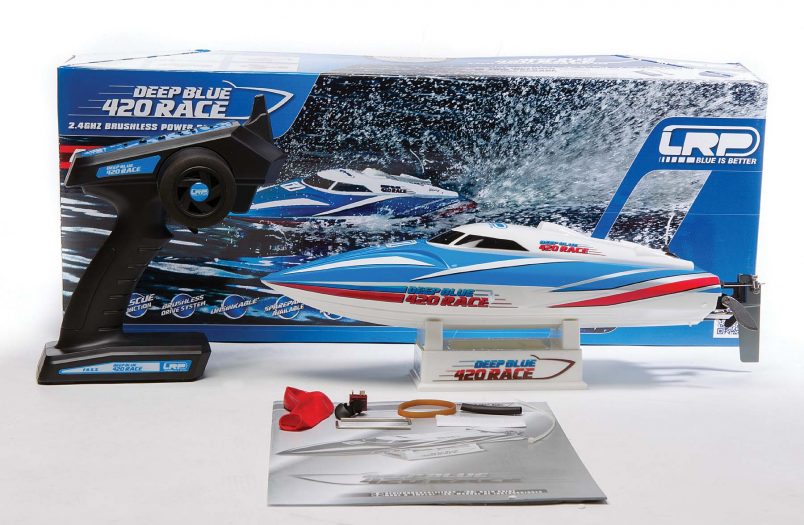
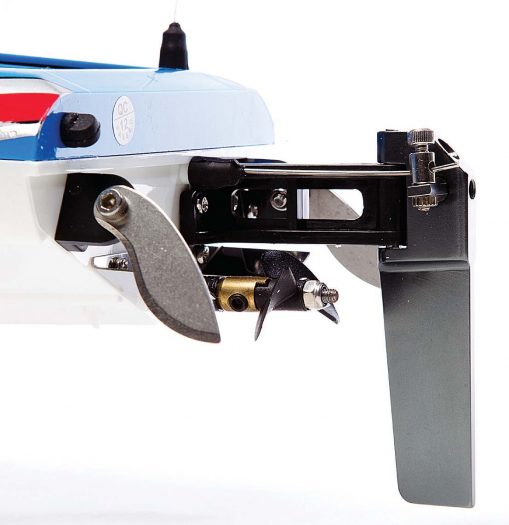
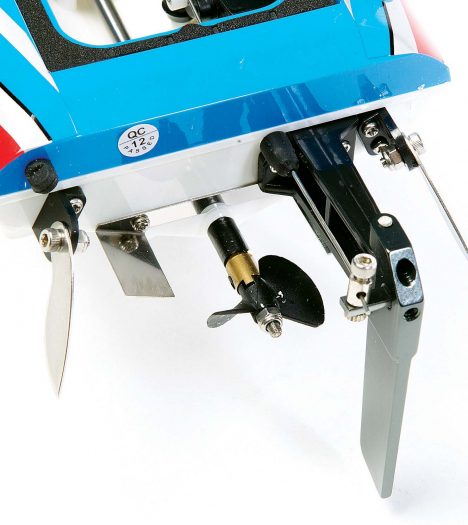
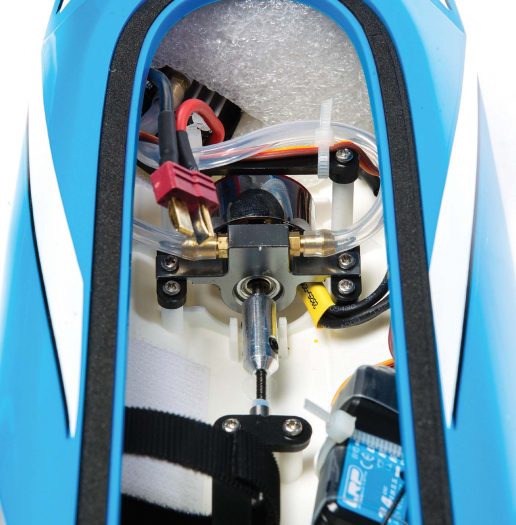
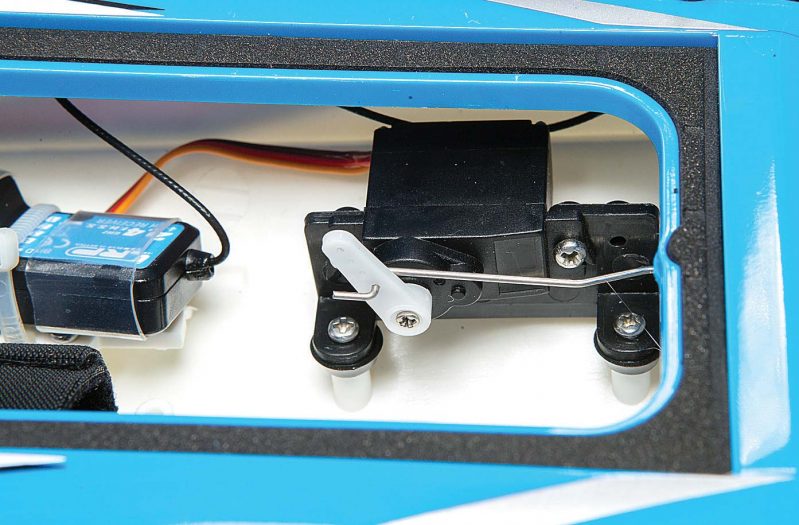
SPECS AND TUNING OPTIONS
Length: 16.5 in. (420mm)
Beam: 4.3 in. (110mm)
Hull Material: ABS plastic
Speed Control: 2-3 Cell 30A
BL water cooled Motor: 2900Kv
Outrunner BL marine motor Prop: 2-blade
Nylon Rudder: Offset right aluminum
Drive System: Direct drive shaft
DOCKSIDE DEDUCTIONS
The LRP Deep Blue 420 Race was an absolute blast in the water for a reasonable amount of money. Top notch, LRP branded electronics power the boat, so you know you are getting some of the best in the business and they per- formed flawlessly in my testing. Even though my day got cut short, I appreciate that the boat was engineered in such a way that the harmful energy from the impact was rerouted to the plastic parts of the boat. This made for an easy repair and I was back out on the water in no time. There are plenty of hours of fun to be had for beginners and experts alike, the Deep Blue flat out rips in open water.
LINKS
LRPlrp-americastore.com
 RC Driver The Best In RC Car & Truck News, Reviews & Video
RC Driver The Best In RC Car & Truck News, Reviews & Video 


